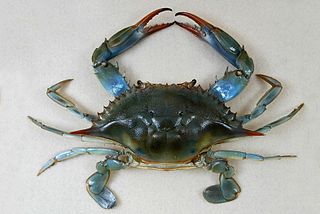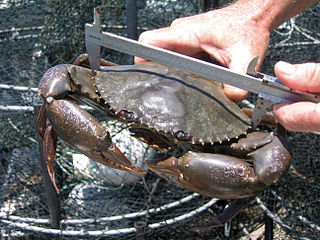
Crabs are decapod crustaceans of the infraorder Brachyura, which typically have a very short projecting "tail" (abdomen), usually hidden entirely under the thorax. They live in all the world's oceans, in freshwater, and on land, are generally covered with a thick exoskeleton, and have a single pair of pincers. They first appeared during the Jurassic Period.

The yellow crazy ant, also known as the long-legged ant or Maldive ant, is a species of ant, thought to be native to West Africa or Asia. They have been accidentally introduced to numerous places in the world's tropics.

The crab-eating macaque, also known as the long-tailed macaque and referred to as the cynomolgus monkey in laboratories, is a cercopithecine primate native to Southeast Asia. A species of macaque, the crab-eating macaque has a long history alongside humans. The species has been alternately seen as an agricultural pest, a sacred animal, and, more recently, the subject of medical experiments.

Hermit crabs are anomuran decapod crustaceans of the superfamily Paguroidea that have adapted to occupy empty scavenged mollusc shells to protect their fragile exoskeletons. There are over 800 species of hermit crab, most of which possess an asymmetric abdomen concealed by a snug-fitting shell. Hermit crabs' soft (non-calcified) abdominal exoskeleton means they must occupy shelter produced by other organisms or risk being defenseless.

Callinectes sapidus, the blue crab, Atlantic blue crab, or regionally as the Maryland blue crab, is a species of crab native to the waters of the western Atlantic Ocean and the Gulf of Mexico, and introduced internationally.

The Japanese spider crab is a species of marine crab that lives in the waters around Japan. It has the largest known leg-span of any arthropod.The Japanese name for this species is taka-ashi-gani,, literally translating to “tall legs crab”. It goes through three main larval stages along with a prezoeal stage to grow to its great size.

King crabs are a taxon of decapod crustaceans that are chiefly found in cold seas. Because of their large size and the taste of their meat, many species are widely caught and sold as food with the most common being the red king crab.

Horseshoe crabs are marine and brackish water arthropods of the family Limulidae and the only living members of the order Xiphosura. Despite their name, they are not true crabs or crustaceans: they are chelicerates, most closely related to arachnids such as spiders, ticks, and scorpions.

Scylla serrata is an ecologically important species of crab found in the estuaries and mangroves of Africa, Australia, and Asia. In their most common forms, their shell colours vary from a deep, mottled green to very dark brown.

The crab-eating fox, also known as the forest fox, wood fox, bushdog or maikong, is an extant species of medium-sized canid endemic to the central part of South America since at least the Pleistocene epoch. Like South American foxes, which are in the genus Lycalopex, it is not closely related to true foxes. Cerdocyon comes from the Greek words kerdo and kyon (dog) referring to the dog- and fox-like characteristics of this animal.

The crab-eating raccoon or South American raccoon is a species of raccoon native to marshy and jungle areas of Central and South America. It is found from Costa Rica south through most areas of South America east of the Andes down to northern Argentina and Uruguay. Despite its name, this species does not feed exclusively on crabs, and the common raccoon also seeks and eats crabs where they are available. In Paraguay, it is known as aguará or agoará popé from Guarani.

Carcinus maenas is a common littoral crab. It is known by different names around the world. In the British Isles, it is generally referred to as the shore crab, or green shore crab. In North America and South Africa, it bears the name European green crab.

Portunus pelagicus, also known as the flower crab, blue crab, blue swimmer crab, blue manna crab or sand crab is a species of large crab found in the Indo-Pacific, including off the coasts of Indonesia, Malaysia, Cambodia, Thailand, the Philippines, and Vietnam; and in the intertidal estuaries around most of Australia and east to New Caledonia.

The Jonah crab is a marine brachyuran crab that inhabits waters along the east coast of North America from Newfoundland to Florida. Jonah crabs possess a rounded, rough-edged carapace with small light spots, and robust claws with dark brown-black tips. The maximum reported carapace width for males is 222 mm, while females rarely exceed 150 mm. It is the closest relative to the European brown crab in the Western Atlantic.

The Majoidea are a superfamily of crabs which includes the various spider crabs.

Johngarthia is a genus of crabs in the land crab family Gecarcinidae, formerly included in the genus Gecarcinus, and containing six species. The genus bears the name of John S. Garth, a 20th century naturalist who specialized in crabs and other arthropods.

Crab fisheries are fisheries which capture or farm crabs. True crabs make up 20% of all crustaceans caught and farmed worldwide, with about 1.4 million tonnes being consumed annually. The horse crab, Portunus trituberculatus, accounts for one quarter of that total. Other important species include flower crabs, snow crabs (Chionoecetes), blue crabs, edible or brown crabs, Dungeness crab, and mud crabs, each of which provides more than 20,000 tonnes annually.

The coconut crab is a species of very large terrestrial hermit crab, and is also known as the robber crab or palm thief. It is the largest terrestrial arthropod known, with a weight of up to 4.1 kg (9 lb). The distance from the tip of one leg to the tip of another can be as wide as 1 m. It is found on islands across the Indian and Pacific Oceans, as far east as the Gambier Islands, Pitcairn Islands and Caroline Island and as far south as Zanzibar. While its range broadly shadows the distribution of the coconut palm, the coconut crab has been extirpated from most areas with a significant human population such as mainland Australia and Madagascar.

Percnon gibbesi is a species of crab. It is one of at least two species commonly called Sally Lightfoot, and is also referred to as the nimble spray crab or urchin crab. It has been described as "the most invasive decapod species to enter the Mediterranean".
Declawing of crabs is the process whereby one or both claws of a crab are manually detached before the return of the live crab to the water, as practiced in the fishing industry worldwide. Crabs commonly have the ability to regenerate lost limbs after a period of time, and thus declawing is viewed as a potentially more sustainable method of fishing. Due to the time it takes for a crab to regrow lost limbs, however, whether or not the practice represents truly sustainable fishing is still a point of scientific inquiry, and the ethics of declawing are also subject to debates over pain in crustaceans.


















